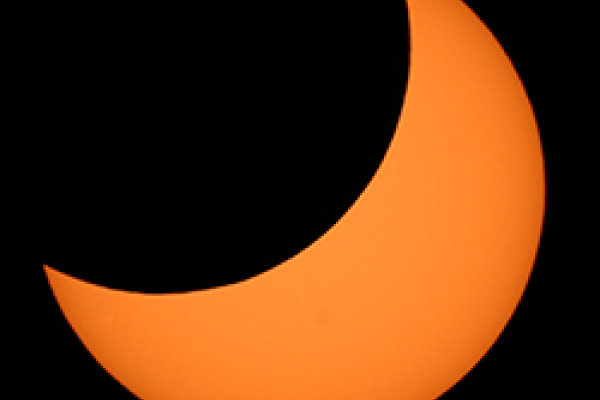What's Up? - Ohio Skylights April 2024

Solar Eclipse Edition
The long-awaited 2024 solar eclipse is upon us! Cross your fingers for clear skies onMonday, April 8th, because it will be quite a sight.
What is a Solar Eclipse?
An eclipse is when light from one celestial object is obscured to an observer by another body passing between them. In other words - the alignment of three bodies in such a way that one blocks light from another from the perspective of the third. In a solar eclipse, the moon obscures the sun’s light from our perspective on Earth.
When and where will it be visible?
Since the moon is smaller than the Earth, its shadow only covers a small fraction of Earth’s surface. Areas within the moon’s umbra are located in the Path of Totality, and will experience a total solar eclipse. During totality, the moon will fully block out the sun. Locations within the moon’s penumbra will experience a partial solar eclipse, where the moon will cover a fraction of the light, but it will not completely cover the sun.
Path of totality for the 2024 solar eclipse is in the image below. It covers a 115-mile-wide path from Texas, through Ohio, and over New England.
Columbus, Ohio is just outside the path of totality. At the midpoint of the eclipse, the moon will obscure 99.7% of the sun’s light. While traffic will likely be difficult to navigate, driving ~30 minutes north or west of Columbus will allow you to experience totality. Eclipse2024.org has a useful search tool that highlights Ohio cities within the path of totality, along with facts about the eclipse’s duration and the time of totality. For all locations in Ohio, the eclipse will begin (the moon’s first contact with the sun) around 2 pm, and totality will begin between 3:10 and 3:15 pm. Totality only lasts between 2 and 4 minutes, so I highly recommend researching the specific start and end times for your viewing location using the provided link.
What will you be able to see?
A total solar eclipse is divided into four phases: first contact, second contact, third contact, and fourth contact. First contact is when the moon first begins to cover the sun; this is when the eclipse begins. Second contact is the beginning of totality, when the moon is completely obscuring the sun. Third contact is the end of totality, once the sun begins to creep out from behind the moon. Fourth contact is when the moon stops covering any portion of the sun, marking the end of the eclipse.
In the seconds before totality begins, when the sun is near completely obscured, a few fascinating phenomena occur: the Diamond Ring and Baily's Beads. The Diamond Ring is the last of the sun’s light, shining brightly while the moon closes in. It appears as though the sun is the diamond while its glow surrounding the moon is a ring in the sky. As the diamond diminishes in brightness, you are able to see Baily’s Beads. Named for the French astronomer Francis Baily who first noted them during an eclipse in 1836, Baily’s Beads are bright spots along the edge of the moon just before totality begins. The moon’s surface is not smooth; it has mountains, craters, and valleys whose effects can be seen during an eclipse. The sun can shine through these irregularities, highlighting the moon’s rough terrain. Both of these effects are caused by the sun's photosphere being visible which means there is risk to the eyes by observing them.
Diamond Ring:
Baily’s Beads:
During totality, the sky will become dark enough to view stars and planets that are not typically able to be seen during this time of year. The sun will be located in the constellation Pisces, and Jupiter and Venus (which are currently too close to the sun to view at night) will be visible as the sky darkens. Popular constellations such as Cassiopeia and Cygnus will be visible in the northwestern sky in the middle of the day, with Taurus, Orion, and Gemini visible in the east during totality. However, the crown jewel of a total solar eclipse is the ability to observe the sun’s corona, or the outermost layer of its atmosphere. The sun is currently in its active phase and we may be treated to a more intense and dynamic corona during the eclipse. It is safe to remove your eclipse shades if you are inside of totality to observe the sun's corona.
alt="Sun's corona as we will see it in the path of totality"
In the unfortunate event that Ohio weather does not cooperate on April 8th, we can still look forward to the midday darkness and temporary environmental changes that occur during an eclipse. The temperature will drop dramatically, and winds may pick up in reaction to the ‘false night.’ Some nocturnal animals, such as bats, may be seen as well due to the dark skies.
Safe travels to those of you who have plans to view the eclipse elsewhere, and happy observing!
Eye Safety Information
For safety information regarding viewing the solar eclipse, please visit: https://eclipse.aas.org/eye-safety
Sources:
- https://eclipse2024.org/eclipse_cities/states.php?type=partial&state=Ohio&country=USA
- https://www.greatamericaneclipse.com/
- https://www.britannica.com/biography/Francis-Baily
- https://weather.com/science/weather-explainers/news/2024-03-08-total-solar-eclipse-weather
Image Credits
- Solar Eclipse Diagram: https://www.businessinsider.com/solar-eclipse-diagram-2017-8
- Path of Totality: https://www.greatamericaneclipse.com/
- Diamond Ring: https://thejewelerblog.wordpress.com/2017/08/21/diamond-ring-effect-will-add-excitement-to-todays-great-american-eclipse/
- Baily’s Beads: https://science.nasa.gov/resource/baileys-beads/ Credit: NASA/Aubrey Gemignani
- Sun in Pisces: https://stellarium-web.org/
- Corona with stars: https://physicsworld.com/a/the-enduring-mystery-of-the-solar-corona/ Credit: Andreas Möller
- Corona: https://spaceplace.nasa.gov/sun-corona/en/ Credit: NASA/Aubrey Gemignani
